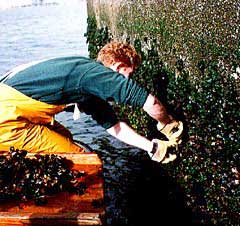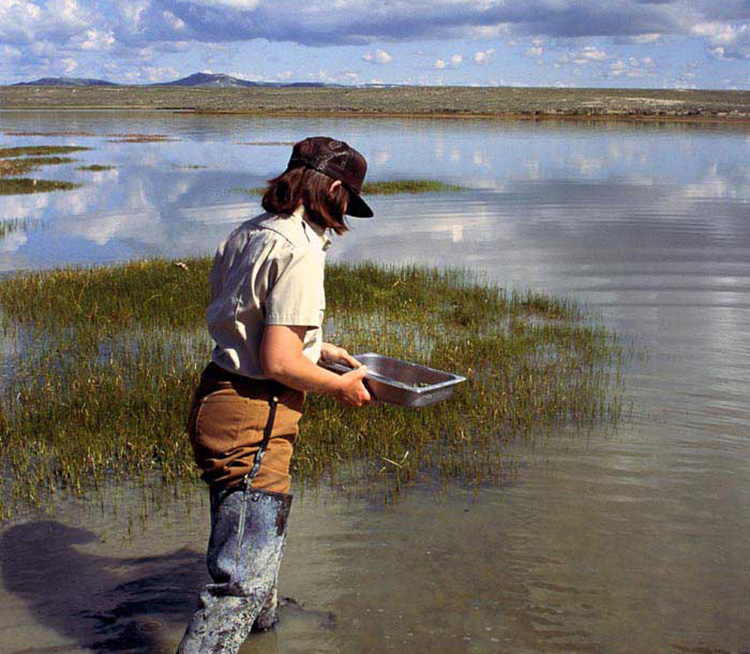Research, Monitoring and Assessment
Pollution Tutorial

NOAA’s Mussel Watch Program monitors the level of chemicals in oysters, mussels, and sediments.
Because nonpoint source pollution poses many threats to environmental and human health, scientists are working hard to effectively manage this problem. Research, monitoring and assessments of the environment are increasing their knowledge of the causes and effects of nonpoint source pollution, and leading to the development of strategies to reduce and control it.
Research
Computer modeling is one technique that scientists are using to better understand how nonpoint source pollution affects waterbodies. A model, or simulation, is a computer program that allows scientists to predict how an environmental "system" like a river, lake, or coastal waterbody may change as a result of varying physical or chemical conditions. Models can also predict the progression and severity of such conditions. With this knowledge, scientists can develop techniques to prevent harmful environmental conditions before they occur.
To develop models, scientists may concentrate on variables that are the most obvious indicators of nonpoint source pollution and potential eutrophication. For example: In a waterbody, nitrate-nitrogen levels above 1 part per million (ppm) and total phosphorus levels above 0.1 ppm can contribute to increased plant growth and eutrophication. Similarly, levels of dissolved oxygen below 1 or 2 ppm may indicate a that a waterbody is experiencing eutrophic conditions. At these low levels of oxygen, aquatic organisms may be starved for oxygen and die.
Scientists will create a model that simulates these conditions, and can then forecast the potential effects of eutrophication, as well as where it might occur.
Monitoring
Research and the use of models provides scientists with important information that they can use to develop long-term monitoring programs. The data gathered from these monitoring efforts is then used to improve the accuracy of the original models.
NOAA's Mussel Watch Project is one example of a monitoring program. It is designed to watch the levels of chemicals in oysters, mussels, and sediments. The project aims to predict trends in pollution across the country and determine which areas are at the greatest risk for contamination. Samples of mussels and oysters are collected every two years, and sediments are sampled once a decade to test for chemical contamination.

Scientists at NOAA, and other agencies, such as the U.S. Geological Survey (USGS) and the U.S. Environmental Protection Agency, sample sediments through various long-term monitoring programs. One program, the USGS National Water Quality Assessment program, has been collecting and analyzing river sediment data across the country since 1991. Scientists test for nutrients and pesticides that are used in nearby agricultural, urban and suburban areas.
The U.S. Geological Survey's National Water Quality Assessment (NAWQA) program is another example of a long-term monitoring project. Since 1991, NAWQA has been collecting and analyzing data at river basins and aquifers (layers of rock or soil that contain large amounts of water) across the country. Scientists monitor for nutrients (nitrogen, phosphorus, etc.) and pesticides that are frequently used in agricultural operations and suburban areas.
NOAA's National Estuarine Eutrophication Survey compiled data gathered from 138 estuaries in the United States. The data revealed that more than 90 percent of U.S. estuaries exhibited eutrophic symptoms. More than half of the estuaries exhibited moderate to high levels of at least one eutrophic symptom, such as low oxygen levels, loss of submerged aquatic vegetation (SAV), or the presence of harmful algal blooms (HABs). Estuaries along the Gulf of Mexico and the Mid-Atlantic Coast showed the highest levels of eutrophic symptoms. These areas suffer the most intense agricultural use and urban runoff.
Assessments
Research using computer models combined with long-term monitoring allows scientists to assess conditions, determine the relationships between nonpoint source pollution and its impacts, and recommend standards and strategies to control pollution.
Assessments are used to help plan control strategies. In 1998, the U.S. Environmental Protection Agency (EPA) published the National Strategy for the Development of Regional Nutrient Criteria. The strategy is an effort to develop specific criteria for nutrient levels in waterbodies, which will help states implement sound water quality standards.
Other control strategies include state coastal nonpoint pollution control programs, which are mandated under the Coastal Zone Act Reauthorization Amendments (CZARA) of 1990. The CZARA requires coastal states and territories to develop and implement specific pollution control programs.
Pollution Lessons
- Welcome
- A Brief History of Pollution
- Point Source
- Nonpoint Source
- Urban and Suburban Areas
- Agricultural Operations
- Atmospheric Inputs
- Forestry and Mining Operations
- Marinas and Boating Activities
- Nutrients
- Suspended Sediments
- Pesticides and Toxic Chemicals
- Bacteria, Viruses, and Trash
- Research, Monitoring, and Assessment
- Controlling Nonpoint Source Pollution
- What You Can Do
- References
- Roadmap to Resouces
- Subject Review (PDF)
Categories of Pollution
Pollutants from Nonpoint Sources
